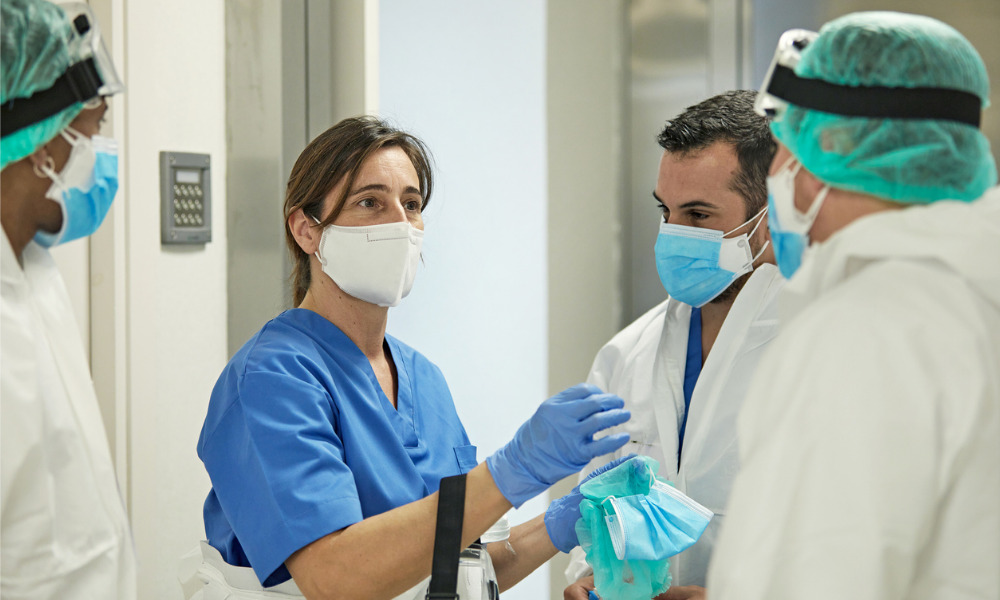New briefing shines a light on how the virus has spread in the workplace

A new briefing by the Institute for Work & Health (IWH), “Incidences of COVID-19 transmissions in Ontario workplaces”, published in January 2021, aims to examine the role of workplaces in COVID-19 transmission in the province and pinpoint information gaps in our understanding of the impact of workplaces in the transmission of the disease among the general population.
The Institute for Work & Health (IWH) is an independent, non-profit organization whose mission is to promote, protect and improve the safety and health of workers. To do this, they conduct actionable research and operate with the support of the Province of Ontario.
COS recently spoke with Dr. Peter Smith, the scientific co-director and a senior scientist at the IWH, about the briefing’s key findings and what they mean for essential workplaces. Dr. Smith is also an associate professor in the Dalla Lana School of Public Health at the University of Toronto.
Read more: COVID: Navigating the return to work
What is an essential service?
According to the IWH, essential service sectors represent around 40 per cent of the Ontario labour force. Which services exactly are essential? These include healthcare, manufacturing, construction, transportation, warehousing, urban transit, distribution and retail (of food, alcohol and pharmaceuticals), among others. Essential service workers are often brought to work in close contact with colleagues and also patients, clients, and customers.
Since the start of the outbreak in Ontario, over three million workers employed in essential services have been working in common settings with others. Since the outset of the pandemic, over 7,900 COVID-19 infections have been attributed to workplace transmissions in essential service settings.
How has the virus spread in the workplace?
“We found that in terms of cases due to workplace outbreaks – which is where two or more people in the same workplace contract COVID-19 within a 14-day period and this transmission could not have occurred outside of work – while the number of these cases have been increasing, they still represent just over five per cent of the total number of cases among the working-age population,” says Dr. Smith.
Indeed, contrary to what some people may believe, workplaces are not the largest vectors of the disease.
“The most common way people get COVID is through close contacts. Not in the workplace, but through close contact with family members or other social contacts. These represent about 50 per cent of the way that people get COVID,” says Dr. Smith.
Read more: Five key surveillance solutions for OHS professionals
How have infections progressed in the second wave?
Dr. Smith says that, in preparing the briefing, the IWH used publicly available data presented on the Ontario Data Portal website.
During this second wave, outbreaks in essential service workplaces (which excludes healthcare, congregate living and educational settings) have contributed to just over five per cent of all cases among working-age adults in the province (defined in the briefing as individuals aged 20 – 69). This, the briefing says, suggests the importance of new workplace practices which have been put into place by employers to curb the spread of the disease (such as masking, physical distancing, encouraging those with symptoms to stay home and self-isolate, etc.).
Looking at the data, we can see that workplace infections are not driving the pandemic – and this can be, in part, due to reasons referenced above. Nevertheless, the briefing also points out that due to the strain placed on contact tracing during this second wave (due in part to the growing number of positive cases), there may be a number of workplace outbreaks not identified in the current available data.
What is the difference between the first and second wave?
How can we compare the first and second wave? There are some consistencies, says Dr. Smith. One of these is that the primary driver of the disease is through community and close contact, meaning that the virus is spreading to family members or other close social contacts.
In addition, “in terms of the proportion of cases due to workplace outbreaks, we do see a difference,” says Dr. Smith. “These cases were much more prominent as a proportion of the overall cases in the first wave of the pandemic.”
In terms of the proportion of cases due to workplace outbreaks, the peak was in June and concerned large outbreaks in farm or agricultural settings, for example.
During this second wave, though the absolute number of cases attributed to workplace outbreaks has increased, so too has the number of cases not due to workplace outbreaks and, as a result, these only contribute between two to five per cent of all cases among the working-age population in the second wave.
Ultimately, though workplaces may not be the most important vectors of transmission, it is essential for employers and employees alike to remain vigilant, keep informed of changes and respect COVID-19 guidelines.





